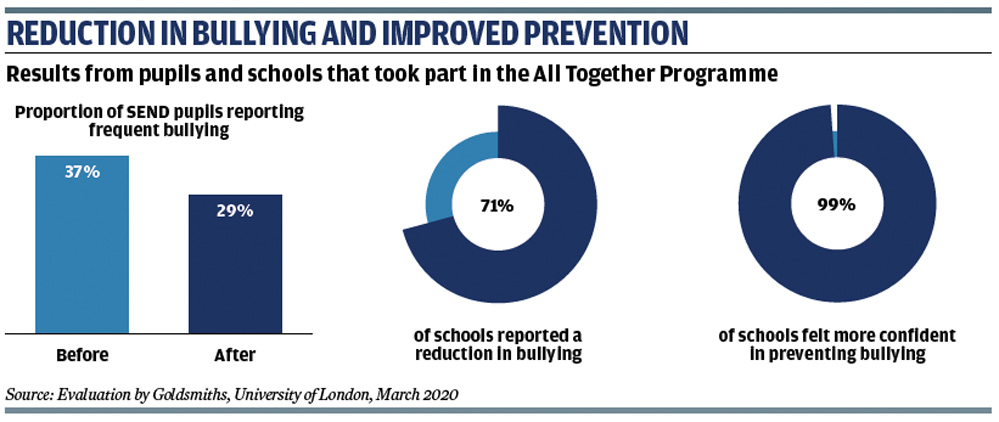
PROJECT
All Together Programme
PURPOSE
To reduce bullying, particularly of children with special educational needs and disabilities (SEND)
FUNDING
The programme is funded by the Department for Education. It received £246,000 of funding in 2020/21
BACKGROUND
In 2015 the Anti-Bullying Alliance established a programme that aimed to reduce the bullying of young people with SEND through a network of school-based “anti-bullying champions”. “Children with SEND are disproportionately involved in bullying,” says Nicola Murray, head of programmes at the Anti-Bullying Alliance. The All Together Programme, which launched in April 2017, developed this work further, aiming to reach more schools using an online platform. It focuses on children with SEND but also includes other vulnerable groups such as young carers, children who receive free school meals, looked-after children, children from particular ethnic or faith backgrounds and those perceived to be LGBT (lesbian, gay, bisexual or transgender). “If you are getting anti-bullying policies and practice right for young people with SEND, then you are likely to be putting in place the right things for all vulnerable groups,” says Murray.

ACTION
The overall aim of the programme is to establish All Together Schools, which take a whole-school approach to tackling bullying involving pupils, teachers, support staff, parents and governors. The free programme is delivered by the Anti-Bullying Alliance with support from Achievement for All, a not-for-profit organisation that works to improve outcomes for children and young people, and Contact, the charity for families with disabled children. The programme’s underlying philosophy is “the social model of disability”, which says people are disabled by barriers in society, not by their own impairment or difference. The model aims to highlight and remove these barriers, offering disabled people more independence, choice and control.
Participating schools must complete an audit of their current anti-bullying practice looking at staff training and development, how they respond and intervene, prevention work, data collection and evidence, school policy and school leadership. The audit tool, accessible through the All Together online hub, has 40 different criteria and schools have to say whether each is being completely met, partially met, or not yet met.
The criteria include having a range of methods of reporting bullying that meet the needs of all pupils, having a school governor who leads on anti-bullying activity and monitors school action in this area, and using a range of interventions to respond to bullying. “Schools were pleased we had broken it all down for them into bite-size chunks,”says Murray. “They could see strengths and weaknesses and what to focus on.”
Schools can also access a pupil questionnaire, which allows them to gather data on pupils’ wellbeing and experiences of bullying, both as victims and perpetrators. The wellbeing strand of the survey was developed in collaboration with the Anna Freud Centre and the Evidence Based Practice Unit at University College London. “The questionnaire is important,” says Murray. “Schools might say they don’t have a problem with SEN bullying but then they see the results from their own pupils and it is undeniable.”
Schools use the results of the audit and the pupil questionnaire to create a tailored anti-bullying action plan. The online hub contains resources to help implement this action plan, including material to help tackle bullying of at-risk groups, best practice guidance and case studies from other schools. Schools can also access online certified training for all staff, including a module on cyberbullying.
At the end of the programme, the questionnaire and audit are carried out again, to monitor progress.
In some areas the All Together Programme also included face-to-face training delivered by Achievement for All. Parents and carers of disabled children and those with SEN could access advice and support through a helpline delivered by Contact.
Schools taking part in the programme can achieve gold, silver or bronze All Together School status. These quality marks are designed to encourage schools to celebrate the fact they are taking serious action in reduction of SEND bullying and include a logo schools can use. Gold schools must complete the pupil survey at the start and end of the programme and show evidence of improvement in pupils’ wellbeing. Silver schools may only have completed one questionnaire but still need to show evidence of progress. “If a school isn’t looking at what the questionnaire says and using it to inform its action plan policies, it becomes a tick-box exercise,” says Murray. Bronze schools must have carried out the whole-school audit but may not have completed either questionnaire.

OUTCOME
An evaluation carried out by researchers from Goldsmiths, University of London, published in March 2020, analysed data from the pupil questionnaire from 216 schools. This showed bullying reduced over the course of the programme, whether that was experience of being bullied or pupils bullying others. The percentage of children who said they were ever bullied fell from 80 per cent to 77 per cent overall, and from 83 per cent to 77 per cent among children with SEND. Frequent victimisation also decreased across the board from 27 to 24 per cent with the biggest reduction reported by pupils with SEND – 37 per cent down to 29 per cent. The proportion of children who said they had bullied others also fell from 43 per cent to 38 per cent while those who said they frequently bullied others fell from eight to five per cent.
The evaluation found 99 per cent of schools that completed All Together reported they felt more confident in preventing and responding to bullying as a result of the programme while 98 per cent had an understanding of the most effective ways of preventing and responding to bullying. Some 94 per cent had improved their understanding of bullying of those with SEND. More than seven in 10 – 71 per cent – of schools said bullying had been reduced and 66 per cent said behaviour had improved.
According to the Anti-Bullying Alliance, nearly 4,000 schools have participated in the programme. Of these, 892 have so far achieved All Together School status, with 283 attaining gold status. The online anti-bullying training courses were used by 16,000 professionals and rated “good” or “excellent” by 95 per cent. Face-to-face training has reached 1,102 school leads and 1,336 members of the children’s workforce.
Some 20,000 people accessed the online parent information tool on bullying, and 94 per cent said they felt more confident about issues relating to bullying as a result of using it. Meanwhile, around 400 parents and carers of young people with SEND received direct advice on bullying from Contact’s helpline.
WHAT’S NEXT?
The Anti-Bullying Alliance is looking at how to make the online resources and questionnaire available to schools after the programme’s funding ended in March 2021. “There might be a bit of a gap but we have built this bespoke platform and we have these resources – it will be back but possibly under a different name,” says Murray.
- If you think your project is worthy of inclusion, email supporting data to derren.hayes@markallengroup.com

